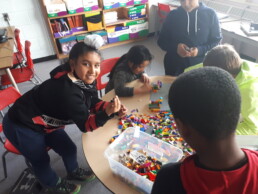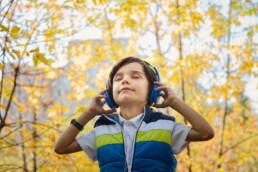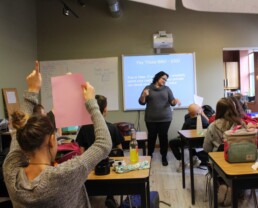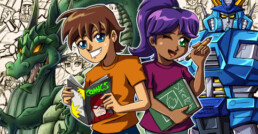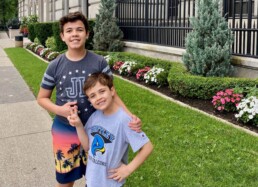Travel Indigenous Canada
Tanshi, Hello, Aniin, Bonjour!
As summer travel season is upon us, I thought I’d take a moment to highlight ways in which we can enjoy both travelling around, and educating ourselves about the Indigenous Nations of Turtle Island (aka North America). Oftentimes, Canadians think they must travel to somewhere like Europe or Asia to experience a rich variety of cultures and languages, when in truth we have over 630 First Nation communities representing more than 50 distinct Indigenous Nations and 50 Indigenous languages right here in this land called Canada (Census 2016). These numbers do not even include the many Inuit communities of the Arctic region, or the extensive Métis Nation. With over 2 million people identifying as Indigenous in Canada, or 6.2% of the population, isn’t it time we educate ourselves about the diverse Indigenous Nations here in our own backyard and approach travel on Turtle Island the way we approach travel abroad?
Now, let’s imagine you are going to take a trip across Canada, but instead of going province by province you decide to travel Nation by Nation. What would that look like and where would you even begin? First thing you could do is find out whose traditional lands are you on. If you are unsure, a great place to start is an app called “Whose Land”. This app allows you to search communities based on location by typing in a city/region or using the Where Am I? feature. You will then be given information related to whose ancestral and traditional territories you are visiting, any treaties or agreements from that area, and links to First Nation communities currently residing there you can explore.
While this is a good place to start, your journey it is only a beginning. Going beyond just acknowledging whose traditional lands you are visiting does require a bit more research, but so does a trip to Italy, right? Once you’ve figured out whose land you are visiting, maybe next you would like to learn about that Nation’s history (outside of the usual colonial narrative of course). You could start with a search online, ideally looking for resources created by Indigenous people or featuring Indigenous voices. You could watch a video about a particular Nation or listen to stories from that community – there are so many wonderful Indigenous created resources out there that you could get happily lost for days exploring history, language, culture of any one Nation.
Follow up by doing some research to see if there are any Nation-led museums or Cultural Centers available to the public you could visit. For example, maybe you are visiting southern Alberta - traditional territory of the Blackfoot/Niitsitapi Nation – you could check out Head-Smashed-in Buffalo Jump: an Interpretive Centre that preserves and interprets over 6,000 years of Plains Buffalo culture. Or maybe you’d like to journey to the East coast and want to learn a little more about Mi’kmaq culture. How about visiting Metepenagiag Heritage Park located in Red Bank, New Brunswick, here you can tour the Interpretive Centre, experience storytelling, and walk the lands learning from Mi’kmaq guides and Elders along the way; you can even learn a few Mi’kmaq words while you are there!
Which leads me to my next suggestion: learning some words in the local Indigenous language. When you travel to Spain or Mexico, it’s common to learn a few words like ‘hola’ and ‘gracias’, so why not learn how to say a few words in the Indigenous language of the Nation whose lands you are on? How about
learning to say Tanshi - hello in Michif the language of the Métis. Or you could learn to say Oki - hello in Blackfoot/Siksikáí’powahsin, or a simple Miigwech – thank you in Ojibway/Anishinaabe. Many Indigenous languages have and continue to be lost to history making it more important than ever for all Canadians to take a role in supporting Indigenous languages and their revitalization. Even learning a few words helps.
Travel is an education that allows us to learn about language and culture from the perspectives of the people who are from that land. Journey in any direction from where you are right now and I guarantee there are stories you have yet to learn; stories waiting for you from the land, from the people, from each community and every Indigenous Nation of Turtle Island. Go educate yourself, approach learning about Indigenous Nations the way you would approach learning about any culture whose lands you travel through; be genuine, be open, be kind, and listen. I know you will be grateful you took the journey.
Happy Travels!
Marsee, Thank you, Miigwech, Merci
The Building Blocks For Great Ideas
The LEGO program for kids is full of amazing STEM-based extra-curricular activities that Extra Ed offers as a lunchtime or after school program. We build different projects with themes such as cities, castles, animal habitats, amusement parks, the four seasons, four elements, and much more. We focus primarily on engineering (how best to make the structure sturdy so it doesn’t fall over) all the while making each activity fun and engaging by students working on such developmental skills as teamwork, communication, fine motor skills, and problem solving.
When given the theme at the start of each LEGO class, the children participate in a creative and imaginative brainstorming session with their group, and discuss what they can build for each structure. Watching the children build and letting their imaginations take over is a huge part of why I enjoy teaching this class. It just starts off with an idea from the instructor. From there, it is incredible to watch the depths of students’ imaginations while still keeping with the theme and parameters of the build. When the students build cities, we discuss what goes into a real city: such as houses, roads, traffic lights, buildings. And when they build a house, the discussion is, will it be 1 storey or 2? How will you build the second story? How will you build a TV, chairs, couches, different rooms? Will you build a roof, but if you do, we can’t see what’s inside? Once they finish the house, the instructor then guides them to build the outside; front lawn, backyard, swing set, swimming pool, gardens, garage, driveway.
When we build sports arenas, the brainstorming sessions go wild. The students mention soccer fields, football fields, baseball diamonds, gymnastics studios, swimming pools, tennis courts just to name a few. But then the big question from the instructor comes: For soccer or football, are you just going to use green pieces? For pools, are you just going to use blue? For hockey rinks, are you just going to use white? Some of the students say yes, and then the imagination begins… what about the white pieces for the out of bounds lines, goalie creases, the white lines for the yardage, different colour pieces to differentiate the swimming pool lanes, the red line, blue line, centre ice. The bleachers, concession stands, locker rooms. Then some students take it one step further: getting a smaller LEGO board and making a scoreboard for the arenas. The parking lot outside. Sometimes, students even build an arch way with initials of the stadium.
All of these discussions serve as the backbone of the epicentre of what goes into running these incredible hands-on programs. As an instructor, it is amazing to see the students take a general theme such as a sports arena, and just run with it and build these structures with their classmates. In every class, once the students start building in groups, the teachers go around to them and help them build and discuss some more ideas. At the end of the class, students walk around and have a chance to showcase to everyone else what they built and can present to their fellow LEGO Engineers.
Extra Ed teaches French? Bravo!
French is the fifth most common language in the world. More than 300 million people across the five continents speak French. Yet only 30% of French speakers have French as their first language, so the majority of francophones have, in fact, learned French as a second language. Why do so many people choose to learn French? I am a Francophone myself and I believe I have a partial answer to this question.
Le français est la cinquième langue du monde. Plus de 300 millions de personnes à travers les cinq continents la parlent. Et pourtant, seulement 30 % des francophones le sont de naissances. Donc, la majorité des francophones ont, en fait, appris la langue française. Ici, une question se pose : pourquoi apprend-on le français ? Je suis moi-même francophone et je crois avoir une réponse partielle à cette question. We often hear that the French language is difficult to master, that it is too complex and that it’s full of annoying exceptions. It’s true that these criticisms are sometimes justified, but the fact is that the complexity of French is also why we love this language so much. Its complexity offers us infinite possibilities of expression - it is complete in the sense of language. In general, if a language is difficult to master or is considered complex, it is because it allows us to communicate in a particularly full and rich way.
On entend souvent dire que la langue française est difficile à maîtriser, qu’elle est pleine d’exceptions agaçantes ou qu’elle est complexe. J’avoue que ces critiques sont parfois justifiées. À vrai dire, elles sont également les raisons pour lesquelles nous aimons tant cette langue. Sa complexité nous offre des possibilités infinies d’expressions. Elle est complète au sens du langage. En règle générale, si une langue est difficile à maîtriser ou considérée complexe, c’est qu’elle nous permet de communiquer d’une manière authentique et singulière.
But why does the French language have so many exceptions? Well, it is because the French language has evolved over a long time and over many distances. French is
derived from Latin - the French that we speak today has developed over two thousand years! As well, French is everywhere: twenty-nine countries have French as their official language, including Canada. Over all this time and in all these places, the evolution of French has resulted in sometimes strange exceptions. You have to admit, through its survival over time and its use in so many places, the French language is clearly recognized worldwide for its beauty and eloquence.
Mais pourquoi la langue française a-t-elle tant d’exceptions ? Et bien, c’est qu’elle est pleine d’histoire. Chaque exception vient avec son lot d’anecdotes. Son origine est Latine, une langue considérée morte aujourd’hui. La construction de la langue que nous connaissons a pris plus de deux mille ans. De nos jours, le français est partout. Vingt-neuf pays l’ont comme langue officielle, incluant le Canada. Sa valeur est, sans contredit, reconnue dans le monde entier pour sa beauté et son éloquence.
I have so much more to say about the French language, but I will conclude by saying that the exercise of simply learning another language has many benefits both for the mind and the spirit. Learning another language opens up your cultural horizons and increases your understanding of the world. Learning French is an adventure through time and around the world – it’s exciting and offers you gigantic advantages. That’s French for you!
Pour conclure, j’aurais tellement plus à dire de la langue française. Apprendre une deuxième langue, ou même une troisième est un exercice aux nombreux avantages tant au niveau cognitif qu’au niveau du développement personnel. Vous ouvrirez vos horizons culturels et vous développerez votre empathie. Vous aurez une longueur d’avance professionnelle et bien plus encore. Apprendre le français est une aventure à travers le temps et autour du monde, qui vous offre des avantages gigantesques. C’est ça le français
Making Music for the World to Hear
“Music enhances the education of our children by helping them to make connections and broadening the depth with which they think and feel. If we are to hope for a society of culturally literate people, music must be a vital part of our children’s education.” – Yo-Yo Ma
From Greek philosophers to the great minds of the Renaissance; to some of the most renowned intellects of the modern day, it is agreed that music is essential to a holistic education. Our music programs seek to build musicianship while addressing the emotional, social, and academic needs of students. Using their instrument (voice, guitar, ukulele, etc.), coupled with a communal learning environment, students are challenged to learn new skill sets with a deeper understanding of how to achieve their own success. An understanding which will propel students into the world around them.
“Music education opens doors that help children pass from school into the world around them – a world of work, culture, intellectual activity, and human involvement. The future of our nation depends on providing our children with a complete education that includes music.” – Gerald Ford
We understand that learning an instrument requires patience, diligence, and practice. These can all be better cultivated through a curriculum designed by students – for students. As a former private music instructor, I have experienced firsthand the shortcomings of an outdated curriculum. Music is a constantly evolving artform, therefore its pedagogy must evolve too. Thus, the shift from classic scale/workbook song to personally catered and more accessible popular song. We also understand that not all students will continue their musical training to a professional level. Therefore, our main goal is not to train the next Mozart by means of technical proficiency, but rather inspire students to remain lifelong learners through musicality.
“Elemental music is never just music. It’s bound up with movement, dance and speech, and so it is a form of music in which one must participate, in which one is involved not as a listener but as a co-performer.” – Carl Orff
Our programs are best understood through the lens of music’s basic building blocks: rhythm, harmony, and melody. The instrument (voice, guitar, ukulele, etc.) is the vehicle we use to explore the building blocks which make up music’s beautiful playground. Whether we are exploring using chord shapes and progressions in our guitar/ukulele programs, or movement and dance in our sing-along programs; students are constantly developing a wide set of skills ranging from memorization, motor skills, self-confidence, and performance. This development is compounded by an individual’s volition, which is why the curriculum is catered to each classroom. Rather than teach these through classic methodology, we opt to use popular music chosen by the students. Further endorsed through communal learning, students now perform with and for their peers using music they have elected.
“With music, one’s whole future life is brightened. This is such a treasure in life that it helps us over many troubles and difficulties. Music is nourishment, a comforting elixir. Music multiplies all that is beautiful and of value in life.” – Zoltan Kodaly
The value of music outside of the classroom is of paramount importance. That is why we are driven to connect students to music that has significance in their lives, and a means to explore those riches with an understanding that is all their own. In doing so, we foster a love for music and the arts that lasts an entire lifetime.
Making Films is a REEL Good Time
I've taught at Extra Ed for the past year now and it's been a wonderful experience. Since I was 16 years old, I’ve been a passionate filmmaker. I started off creating films with my friends in high school, and soon moved on toward bigger projects, like an award-winning web series that received tens of thousands views on YouTube. Yet despite these successes, one of the biggest achievements in my filmmaking journey was working at Extra Ed. I was deeply happy when I first received the offer to instruct in my craft. It's such a fulfilling feeling to be able to teach something that I love. I always find the students have something to teach me too, and the work they create never ceases to amaze me.
Filmmaking is more than just the flashing lights, movie stars, and popcorn action movies. When people think of movies they think of Clint Eastwood and a sunset in the background. But it’s more than that. It's about the telling of a story, the creative process, the expression of the artist. So much can be learned from filmmaking that can be applied not only to arts, but to other faculties as-well. Someone skilled in the arts of directing will likewise be skilled in jobs involving leadership, like CEO’s or managers. A skilled filmmaker will learn how to solve problems, work under deadlines, and most importantly, express themselves in an authentic and unique way.
The curriculum is designed in a way to help students make friends, but also learn the art of film in the easiest and most pleasant way possible. Students begin by analyzing several types of films: music videos, commercials, movies. Once they begin to distinguish the different types, they are encouraged to begin working on films of their own. Starting off simple, with the first project being a short 30-second compilation of stock footage, the projects gradually increase in difficulty. Ranging by the end from trailers, YouTube videos, commercials, and even short narrative films of their own! By the end of the program, all students will not only have a basic knowledge of film and film editing, but also have two to four short films of their own!
Our programs have been made accessible to students worldwide through use of our online and virtual learning courses! Weekly, but also offering a PA day program for any students on the fence about film, or just wanting to walk away with a brief glint of filmmaking expertise. The course is fun for everyone! For amateurs, to experts, there’s always something new to learn regarding the filmmaking experience. It's been an honor teaching at Extra Ed, and I genuinely believe any student who signs up for the film program will walk away amused, and more apt in a real-life applicable skill that's not taught much elsewhere.
Get Into STEM with Coding!
The curriculum for our coding classes was developed back in July when we were restructuring our STEM programs to offer them online. These coding for children lessons are all games and animations that can be made in an easy platform, and their intent is to teach our students the core aspects of programming logic that are so vital to develop interest in STEM.
The Scratch platform allowed us to make some very fun stuff! For example, the kids really liked a tennis game we developed, especially because some of them enjoyed playing and watching real-life tennis matches. In game projects that involve heroes and ghosts, children were able to make full use of their imaginations and create their own characters. It has been great to see most of our students come back for more Extra Ed coding lessons, a sign that they have been truly enjoying the course.
This program also transforms coding from an abstract combination of words into concrete applications that relate to problems young students face in their real lives. When decisions need to be made, for instance, people rely on different conditions to decide what to do. In Scratch, programming blocks that contain conditional statements may be compared to how drivers need to act when they see a traffic light:
- If the light is red, then I need to stop the car and wait until I can go again.
- If the light is yellow, then I need to reduce my speed and stop before it turns red.
- If the light is green, then I am free to go!
Python coding for kids is another great coding program. On this course, students learn how real programming languages work and develop projects that involve clever solutions to complex problems. They also learn how computers read and interpret code under the hood, and how to write efficient and well-documented code.
Having organized documentation is important even for the ones who do not wish to pursue a career in coding and development, as it helps everyone to communicate ideas and work well within groups. And the ones who wish to go on and program when they grow up, they will have a blast with all the proper naming conventions and how much they help when reading code – especially when reading someone else’s code!
The classes we teach go over the entire syntax and structure of Python language. Moving away from the conditional statements examples, we can dive deep into loops, which are some of the most amazing tools of coding! Loops allow young programmers to make computers perform the same action multiple times in a row – with a few tweaks – for as long as they want. So, if they want the computer to roll a die until the result is 6, they can do so with just a few lines of code, instead of having to write code for each die-roll individually.
Coding is a fantastic science, and it is here to make the lives of everyone easier. And Extra Ed does the amazing job of turning it into a fun and engaging experience.
You can check out our incredible Online Comic Book Art Programs and a ton of other great Extra Ed courses through our Extra Ed content calendar.
Money Managers Learn About Finances
Kids are learning about money, debt, saving and more in Extra Ed’s financial literacy courses, which are conducted both online, after school, and even in classrooms! No class is ever the same though, and all feature unique conversations with students bringing varying topics to the table and making real-world connections to financial terms and tools.
Extra Ed’s Financial Literacy lessons have been developed with a focus on holistic learning. It includes math, social sciences, and even history for some components. Following our famous “Net Worth” tournament-style game, students are guided through a variety of financial concepts to help prepare them to make financially savvy choices for the future! We provide a safe space for students to discuss a variety of financial opinions, and invite exploration of what financial success means to the students. During the program, students are encouraged to use their critical thinking skills to determine different ways to save money and resources through simple everyday changes.
With a focus on different types of debt, ways of savings, and investing, students are guided through a fun and interactive class, packed with games and discussions leaving students ready to start saving! The financial literacy program is designed to be easily understood, while still providing a challenge for anyone at any level of financial knowledge. Extra Ed’s Financial literacy program is designed in a way to help be flexible and accessible for a variety of learning needs and abilities. Here at Extra Ed, we have found that experiences with financial literacy can be extremely beneficial in helping students think about the long term and to develop a healthy respect and appreciation for their money (and the money of their parents). Plus, the students love it!
When moving to the online world, Extra Ed expanded its financial literacy program for kids to reach more audiences throughout the country with the same personal touch we have when conducting these same courses in the classroom. Examining the financial world from a young age helps students gain a sense of ownership in the world and the ability to make sound investment decisions. When students feel more confident in their decisions, they feel encouraged to do their research and advocate for themselves, leading them to develop a responsible financial mindset to help achieve their goals.
Servicing the Greater Toronto Area for over six years, Extra Ed strives on high quality accessible education, focusing not only on meeting learning needs through the practical training of our mentors, but also offering an affordable class. We only charge by pay-what-you-can, even if it's nothing at all, so all you have to focus on is how you’re going to be financially savvy! We encourage everyone to jump right in and join us in one of our online financial literacy classes and experience first hand the impact a great financial literacy class can have on a person! Anyone can learn to be a “Money Manager.” It just makes good “cents.”
You can check out our incredible Online Financial Literacy and Lego Robotics Programs and a ton of other great Extra Ed courses through our Extra Ed content calendar.
Why Comics Matter
Even with easy access to all the variety of digital media that we have these days, comic books are still a popular form of entertainment for kids. In fact, for many kids these days, reading Marvel or DC comics and graphic novels has become a part of everyday life. And reading comics isn’t just fun and games, but also a beneficial way for young people to gain reading experience and expand their imaginations, which can lead to an interest in art.
Of course, reading comprehension will always be important, but by reading comics, children not only improve in their literacy, but also their ability to see and actually understand what they are looking at. By “reading” the images found in comics, kids learn critical thinking and how to infer information based on the artwork. Comics are also a gateway into exploring a wide variety of topics and stories. From school dramas, sports stories, cooking competitions, even classic literature, just about every topic and genre under the sun has been made into a comic book. There truly is something for everyone, and it’s not just super heroes (though super hero comics are still very cool).
Comics also help kids explore different cultures, experiences, and ways of life. By reading internationally produced comics such as Japanese manga or Korean manhwa, kids learn about cultural differences and can become more accepting of others. Today, there are comics made by creators from a wide variety of backgrounds, which can expand the horizons of young comic fans and help them to see the world through the eyes of another.
By reading comics and graphic novels, kids are opened up to new sides of art and expression, with many styles and possibilities. With so much variety available, there truly is something for everyone. As they become comic fans, It’s only natural for kids to want to draw comics of their own, and Extra Ed’s Comic Book/Graphic Novel classes can make that happen! Comics are an ultimate art form, combining so many aspects of creativity, from drawing figures, character design, composition, camera angles, storytelling, perspective, and more. These important topics are all covered over the course of the various levels of the Comic Book/Graphic Novel Creation visual arts program.
By taking classes on how to draw comics for kids, young artists can turn their love of comics into a very fulfilling interest that can last a lifetime. They’ll gain appreciation of the art-form they enjoy and the effort it takes to make it. They also build skills that can be applied to other pursuits in and out of the art world. And they gain a first-hand experience of how learning and practising those skills will yield improvement over time when they apply what they have been taught. When kids start creating comics by drawing their own characters and coming up with stories, they are really expressing themselves and how they feel about what is important to them.
Whether enjoying reading them or drawing their own, the diverse worlds of comics and graphic novels are so much more than just simple entertainment for kids, they are a valuable medium that helps to enrich and inspire the imaginations of children. And let’s be honest, comics are not only just for kids, so a mutual love of comics can act as a way for the entire family to connect. When children become interested in taking classes on how to draw comics for kids, it brings their interest in comics to a whole new level, and we at Extra Ed are ready to help get them started!
You can check out our incredible Online Comic Book Art Programs and a ton of other great Extra Ed courses through our Extra Ed content calendar.
An Interview with Lucas & Nicolas
Lucas and Nicolas are two siblings that love playing video games and reading books. They have been living in Toronto for one and a half years after arriving from Brazil. What else do they have in common? Both have taken Extra Ed programs. Check out below what they thought about it:
Extra Ed: Hello, boys! Before we chat about Extra Ed programs, can you tell us how old are you?
Lucas: I am 13 years old.
Nicolas: I am 8.
Extra Ed: Cool! What programs did you guys take?
Lucas: I did Financial Literacy and Lego Robotics.
Nicolas: I took Lego Robotics and Lego Building programs.
Extra Ed: And what did you guys think about the programs?
Lucas: I honestly liked both of them very much! The instructors were very fun to work with. And the content that we learned was pretty cool. I liked the way they guided Financial Literacy and Lego Robotics programs.
Nicolas: I liked the programs very much. I met new people. I got to build really cool structures.
Extra Ed: What else do you guys remember from the programs?
Lucas: I liked both programs very much. I think I prefer Lego Robotics because I enjoy playing with Lego bricks and adding the robotics to it made the experience awesome. In Financial Literacy, we had our own characters that we developed for group work and made life choices for them. It was a fun way to look at more serious matters such as how we manage our money through life.
Nicolas: They were fun! I had choices to build different things like amusement parks, cities, theme days such as Christmas, medieval times and lots more. In Lego Robotics we could build things that move back and forth and we could access it from a tablet. So, it was really cool!
Extra Ed: That's awesome! Thank you for the chat guys. Let me ask you a last question: I've heard you love playing video games. So, tell us about a cool game you played recently.
Lucas: I am playing Batman Arkham Knight and I love it. Batman is one of my favourite characters and I love driving the Batmobile through Gotham City.
Nicolas: Spider-Man Miles Morales. Miles is my favourite character. I just love him. I have finished the game and I am playing it all over again.
You can check out our incredible Online Financial Literacy and Lego Robotics Programs and a ton of other great Extra Ed courses through our Extra Ed content calendar.
Give Kids an Eye for Photography
At Extra Ed, we like to think that we have an eye for photography. Photography is as rich in educational material as it is a mix of the arts. It uses technology that also touches on math and sciences, making it a tool for life. Not to mention it is a creative outlet that you can pair with any other interest. For example the nature lover might lean towards landscape photography or macro images of flowers and insects; sport lovers might enjoy taking portraits of their friends in action or the person with an impressive action figure collection might love bringing their collection to life through miniature photography.
No matter your interest, there is a way to pair it with photography. The ability to simultaneously encourage a student’s hobby or other interest while learning a new skill is what makes teaching photography so fun. This is also why I rarely dictate the subject matter of a student’s project, rather than instruct them with overarching themes. I want them to find something they are interested in, and then provide students with all the magical tricks to make an image “cool”.
I have been taking pictures myself for over 15 years and personally it has always given me something to be inspired and excited about, even during times of boredom or when I felt creatively stuck. I can pick up my camera and take some close ups of whatever I can find around my house. The act of creation leaves me feeling satisfied with no mess. If I can get a child or young teen inspired enough to see the endless possibilities you have with just a camera and something to photograph, I feel I have done my job.
You can check out our incredible Online Photography Programs and a ton of other great Extra Ed courses through our Extra Ed content calendar.


